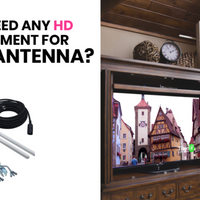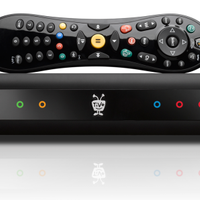Setting up an indoor antenna can feel a bit daunting, but it doesn't have to be! Whether you're a seasoned pro or a total newbie, there are some key things to keep in mind to get the best signal. Let's dive into the process of placing an indoor antenna so you can enjoy the clearest picture and the most channels possible.
Choosing the Right Antenna
Before you even start thinking about where to put your antenna, it's important to pick the right one. Not all antennas are the same, so choose based on your needs. For indoor antennas, consider factors such as distance from broadcast towers, the type of signals you want to receive (VHF or UHF), and whether you need a multidirectional or directional antenna. If you're in a rural area, you may need a more powerful outdoor antenna to pick up signals from further away.
Once you've chosen the right antenna for your needs, it's time to think about placement. Ideally, your antenna should be as high up and as close to a window as possible. Walls, furniture, and other obstructions can block or interfere with signals, so try to keep your antenna clear of any obstacles.

If you're using an indoor tv antenna, experiment with placement to find the best signal. Sometimes moving your antenna just a few inches can make a big difference in signal quality. If you're using an outdoor antenna, make sure it's securely mounted and pointing in the direction of the broadcast towers.
Remember, it may take some trial and error to find the best placement for your antenna. Be patient and keep experimenting until you find the optimal position for the best signal quality.
Types of Indoor Antennas
There are a few different types of indoor antennas to consider:
Flat antennas:
These are easy to mount and often come with adhesive backing, making them perfect for placing on a wall or window. These are typically small and lightweight, making them easy to place and move around as needed.
They are often durable and long-lasting, able to withstand being mounted outdoors or in high-traffic areas.
They come in a variety of styles and can be customized with different colors, designs, and sizes to fit any aesthetic or branding needs.
They are cost-effective, offering a budget-friendly option for adding signage or decoration to a space.
They are versatile and can be used for a variety of purposes, such as displaying information, promoting products or events, or simply adding visual interest to a space.
Rabbit ears:
The classic option, these are adjustable and can sometimes give you more control over signal reception. Some benefits of using an external antenna include:
1. Improved signal strength:
External antennas are often more powerful than internal antennas, which can lead to better signal reception and a stronger connection.
2. Better range:
With an external antenna, you may be able to pick up signals from sources that are further away, leading to a greater range of coverage.
3. Customizable positioning:
External antennas can be adjusted and positioned in different ways to optimize signal reception, allowing you to find the best placement for optimal performance.
4. Reduced interference:
External antennas can sometimes help reduce interference from other electronic devices or obstacles, leading to a clearer and more stable connection.
Overall, using an external antenna can be a great option for those looking to improve their signal reception and have more control over their wireless network.
Loop antennas:
These have a circular design and are known for their range and efficiency. I think you are describing ceiling fans. These appliances are designed with circular blades that circulate air throughout a room to help keep it cool and comfortable. Ceiling fans are popular for their energy efficiency and ability to help reduce heating and cooling costs.
Frequency Range Consideration
Make sure your antenna can pick up both UHF and VHF frequencies. Most modern antennas are equipped for both, but it's good to double-check. This will ensure that you can receive all available channels in your area. It's also a good idea to position your antenna properly to achieve the best reception, such as mounting it outside or in a higher location if possible. If you're still having trouble receiving certain channels, you may need to invest in a larger, more powerful antenna.
Assessing Your Location
Your location plays a significant role in how well your indoor antenna will work. Being in a metropolitan area with strong TV signals will likely result in better reception with an indoor antenna compared to being in a rural area with weak signals. Additionally, factors such as the proximity to broadcast towers, interference from other electronic devices, and the layout of your home can all impact the effectiveness of an indoor antenna. To maximize the performance of your indoor tv antenna, consider experimenting with placement and orientation to find the best reception.
Distance from Transmitters
Check how far you are from broadcast towers. The closer you are, the easier it will be to receive strong signals. One way to check how far you are from broadcast towers is to use online tools such as AntennaWeb (https://www.antennaweb.org/) or TV Fool (https://www.tvfool.com/). These tools allow you to enter your address or ZIP code to see a map of broadcast towers in your area and estimate how far you are from them. Additionally, you can use a TV antenna signal meter to measure the strength of signals from different directions and determine the distance to the nearest broadcast tower.
Signal Interference
Other electronics, thick walls, and even metal furniture can all interfere with signal quality. Try to minimize interference as much as possible. Here are a few tips to help minimize interference and improve signal quality:
1. Keep electronic devices such as cordless phones, microwaves, and baby monitors away from your router.
2. Position your router in a central location and away from walls or large objects that could block the signal.
3. Consider using a Wi-Fi range extender or a mesh network system to extend coverage in areas with poor signal reception.
4. Invest in a router with beamforming technology, which helps direct the signal towards your devices for improved performance.
5. If possible, connect devices to the router using Ethernet cables for a reliable and stable connection.
6. Update your router's firmware regularly to ensure it is operating at its full potential.
7. If you are still experiencing interference, consider investing in a dual-band router that can operate on both 2.4GHz and 5GHz frequencies, as 5GHz signals are less prone to interference.
8. Consider using a Wi-Fi analyzer app to identify any potential sources of interference and adjust your router settings accordingly.
Understanding Signal Maps
Signal maps are a great way to figure out where the best reception areas are in your home. These maps can guide you on where to place your antenna for optimal performance. Signal maps can also help you identify any potential obstructions or interference that may be affecting your signal quality. By using a signal map, you can pinpoint areas in your home where the signal strength is weak and make adjustments accordingly to improve reception.

To create a signal map, you can use a signal strength meter or a smartphone app that measures the signal strength of your TV antenna. Start by moving your antenna to different locations in your home and note the signal strength levels in each area. You can then use this information to create a map that shows the areas with the best and worst reception.
By using a signal map to optimize the placement of your antenna, you can ensure that you get the best possible reception for all of your favorite TV channels. This can help you avoid pixelation and signal dropouts, leading to a better viewing experience overall.
Antenna Placement
Now that you have the right antenna and know your location, let's find the perfect spot for your antenna. When looking for the perfect spot for your antenna, there are a few key factors to consider:
1. Elevation: The higher your antenna is placed, the better reception you will generally receive. Look for a spot that is up high and free from obstructions.
2. Clear line of sight: Make sure that there are no buildings, trees, or other obstacles blocking the path between your antenna and the transmitter. This will help ensure a clear signal.
3. Location of nearby transmitters: If possible, locate your antenna in the direction of the nearest transmitter. This will help optimize signal strength and minimize interference.
4. Stability: Choose a spot where your antenna can be securely mounted and will not be easily affected by strong winds or other weather conditions.
5. Accessibility: Make sure that your antenna is located in a spot that is easy to access for maintenance and adjustments.
By taking these factors into consideration, you can find the perfect spot for your antenna and optimize your reception.
Higher Ground
Placing the antenna on a higher spot in your home can improve reception. Try positioning it on a higher shelf or even on top of your TV. Additionally, try pointing the antenna towards the broadcast tower of the TV station you are trying to receive signals from. This can help improve the strength of the signal and reduce interference.

If possible, avoid placing the antenna near metal objects or other electronic devices that can cause interference. Experiment with different locations and angles to find the best placement for optimal reception.
You may also want to consider investing in a signal amplifier or a more powerful antenna if you are still experiencing poor reception after trying these tips. This can help boost the signal strength and improve the quality of the image and sound on your TV.
Windows and Walls
Windows are your friend when it comes to indoor antennas! Position the antenna near a window facing the direction of the nearest broadcast tower for the best results. Additionally, make sure to avoid placing the antenna near any obstructions such as metal objects or electronic devices that could interfere with the signal. Experiment with the placement of the antenna to find the optimal position for the best reception. You may also consider using a signal amplifier to enhance the signal strength and improve the quality of the reception. With a little patience and experimentation, you can enjoy clear and crisp TV reception with your indoor antenna.
Experimentation
Sometimes, finding the sweet spot involves a bit of trial and error. Move your antenna around different spots in your room to see where you get the strongest signal. Additionally, try adjusting the angle and direction of the antenna to maximize signal strength. Sometimes even a slight tweak can make a big difference in the quality of reception.
You can also try using a signal strength meter or an app on your phone to help determine the best placement for your antenna. This will give you a more precise measurement of signal strength in different locations.
Finally, consider any potential sources of interference in your room, such as other electronic devices or metal objects, and try to position your antenna away from them to improve reception.
By experimenting with different placements and settings, you can find the sweet spot for your antenna and enjoy better signal quality for your TV or radio.
Antenna Setup
Once you've found the best location, it's time to set up your antenna.
Connecting to the TV
Connect the antenna to your TV using the coaxial cable provided. If you're not sure where the input is, check your TV's manual.
Channel Scanning
After connecting the antenna, use your TV's menu to perform a channel scan. This will let you know how many channels you're receiving and whether you need to adjust the antenna.
Maintenance and Optimization
To keep your signal strong, you'll need to do some maintenance and optimization from time to time. Here are some tips to help you maintain a strong signal:
1. Check your equipment: Make sure all cables are connected securely and that your router is working properly. If you notice any damage or issues, consider getting them replaced.
2. Position your router properly: Place your router in a central location in your home to ensure even coverage throughout. Keep it away from walls, metal objects, and other electronics that can interfere with the signal.
3. Update your firmware: Regularly check for updates for your router's firmware and install them as needed. This can help improve performance and fix any bugs that may be affecting your signal.
4. Reduce interference: Keep other wireless devices away from your router, as they can cause interference and weaken your signal. Avoid placing your router near microwave ovens, cordless phones, or baby monitors.
5. Use a strong password: Secure your network with a strong password to prevent unauthorized users from accessing it. This can help reduce the strain on your network and improve your signal strength.
6. Consider a signal booster: If you have a large home or office space, consider investing in a signal booster to extend the range of your Wi-Fi signal. This can help eliminate dead zones and ensure a strong connection in every area.
By following these tips and performing regular maintenance on your network, you can ensure that your signal remains strong and reliable for all your devices.
Fine-Tuning for Best Signal
After the initial setup, you might need to fine-tune your antenna's position for the best signal. Small adjustments can make a big difference! Here are a few tips for fine-tuning your antenna's position:
1. Start by checking the signal strength on your TV or tuner. Most devices have a signal strength meter that can help you determine the best position for your antenna.
2. Move your antenna a few inches at a time in different directions. Sometimes, a slight adjustment can improve the signal significantly.
3. Avoid placing your antenna near large metal objects or electronic devices, as these can interfere with the signal.
4. Try raising or lowering your antenna to see if that improves the signal. Sometimes, a higher or lower position can make a difference.
5. If you're using an indoor antenna, try moving it to a different location in your home. Sometimes, simply changing the placement can improve the signal quality.
6. If you're using an outdoor antenna, make sure it is securely mounted and pointing in the direction of the broadcast towers. You may need to adjust the direction slightly to get the best signal.
7. Consider using a signal amplifier or a different type of antenna if you're still having trouble getting a good signal. Some areas may have better reception with a different type of antenna.
Remember, it may take a bit of trial and error to find the best position for your antenna. Don't get discouraged if it takes some time to fine-tune your setup. With a bit of patience and perseverance, you should be able to get a strong, clear signal for all your favorite channels.
Regular Maintenance
Dust and dirt can affect the quality of your reception. Wipe down your antenna occasionally to keep it in top shape.
Final Words
Placing an indoor antenna doesn't have to be a chore. With the right information and a little bit of experimentation, you'll be watching your favorite shows in no time. Remember, placement is key, so try different spots until you find the one that gives you the best reception.
FAQs
How do I know which type of indoor antenna to choose?
Consider your needs based on your location and the channels you want. Flat antennas are versatile, rabbit ears offer adjustability, and loop antennas are known for range.
How often should I clean my indoor antenna?
Wipe down your antenna every few months to keep it free from dust and debris, which can affect reception.
What should I do if I can't find the right input for the antenna on my TV
Check your TV's manual or look up the model online to find the location of the coaxial input.
How do I know where the best spot for my antenna is?
Experiment with different locations, focusing on higher ground and areas near windows. Signal maps can also help guide you.
Can I use an indoor antenna in a large building or apartment complex?
Yes, you can, but signal interference may be higher due to other electronics and thick walls. Experiment with different locations to find the best spot.






